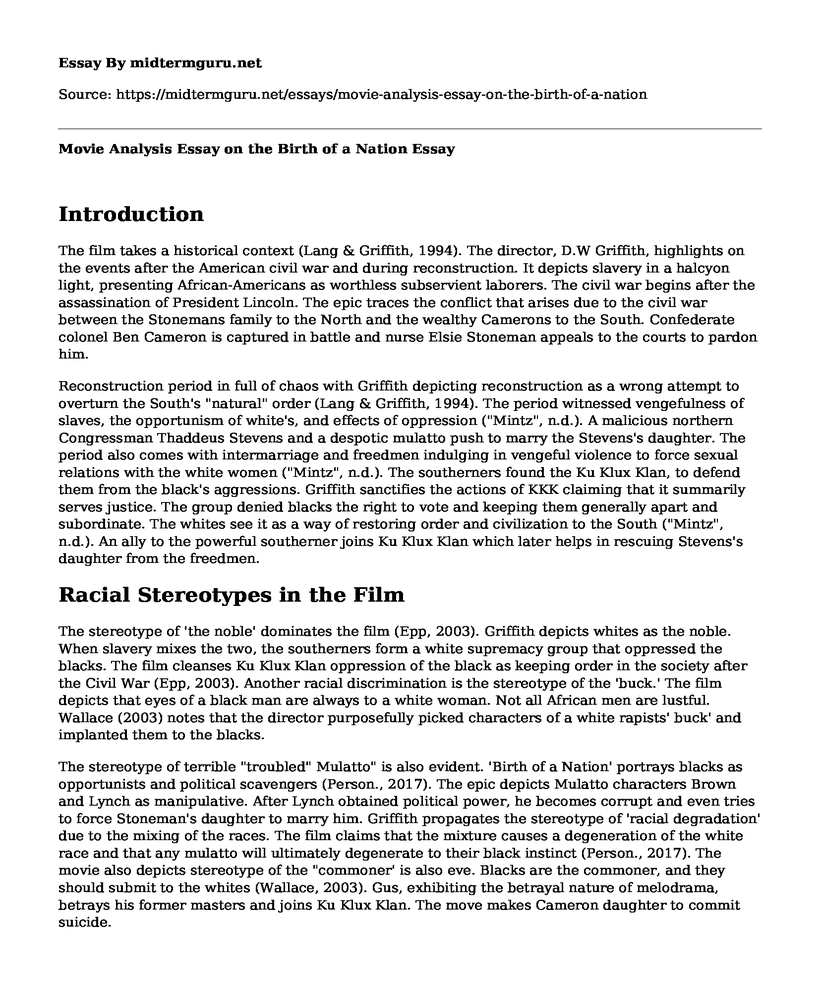Introduction
The film takes a historical context (Lang & Griffith, 1994). The director, D.W Griffith, highlights on the events after the American civil war and during reconstruction. It depicts slavery in a halcyon light, presenting African-Americans as worthless subservient laborers. The civil war begins after the assassination of President Lincoln. The epic traces the conflict that arises due to the civil war between the Stonemans family to the North and the wealthy Camerons to the South. Confederate colonel Ben Cameron is captured in battle and nurse Elsie Stoneman appeals to the courts to pardon him.
Reconstruction period in full of chaos with Griffith depicting reconstruction as a wrong attempt to overturn the South's "natural" order (Lang & Griffith, 1994). The period witnessed vengefulness of slaves, the opportunism of white's, and effects of oppression ("Mintz", n.d.). A malicious northern Congressman Thaddeus Stevens and a despotic mulatto push to marry the Stevens's daughter. The period also comes with intermarriage and freedmen indulging in vengeful violence to force sexual relations with the white women ("Mintz", n.d.). The southerners found the Ku Klux Klan, to defend them from the black's aggressions. Griffith sanctifies the actions of KKK claiming that it summarily serves justice. The group denied blacks the right to vote and keeping them generally apart and subordinate. The whites see it as a way of restoring order and civilization to the South ("Mintz", n.d.). An ally to the powerful southerner joins Ku Klux Klan which later helps in rescuing Stevens's daughter from the freedmen.
Racial Stereotypes in the Film
The stereotype of 'the noble' dominates the film (Epp, 2003). Griffith depicts whites as the noble. When slavery mixes the two, the southerners form a white supremacy group that oppressed the blacks. The film cleanses Ku Klux Klan oppression of the black as keeping order in the society after the Civil War (Epp, 2003). Another racial discrimination is the stereotype of the 'buck.' The film depicts that eyes of a black man are always to a white woman. Not all African men are lustful. Wallace (2003) notes that the director purposefully picked characters of a white rapists' buck' and implanted them to the blacks.
The stereotype of terrible "troubled" Mulatto" is also evident. 'Birth of a Nation' portrays blacks as opportunists and political scavengers (Person., 2017). The epic depicts Mulatto characters Brown and Lynch as manipulative. After Lynch obtained political power, he becomes corrupt and even tries to force Stoneman's daughter to marry him. Griffith propagates the stereotype of 'racial degradation' due to the mixing of the races. The film claims that the mixture causes a degeneration of the white race and that any mulatto will ultimately degenerate to their black instinct (Person., 2017). The movie also depicts stereotype of the "commoner' is also eve. Blacks are the commoner, and they should submit to the whites (Wallace, 2003). Gus, exhibiting the betrayal nature of melodrama, betrays his former masters and joins Ku Klux Klan. The move makes Cameron daughter to commit suicide.
References
Epp, M. H. (2003). Raising minstrelsy: Humour, satire and the stereotype in The Birth of a Nation and Bamboozled. Canadian Review of American Studies, 33(1), 17-36. Retrieved May 13, 2019, from https://www.utpjournals.press/doi/abs/10.3138/CRAS-s033-01-02
Lang, R., & Griffith, D. W. (1994). The Birth of a nation: DW Griffith, director (Vol. 118). Rutgers University Press.
Mintz, S. (n.d.). The Gilder Lehrman Institute of American History. Retrieved May 13, 2019, from https://www.gilderlehrman.org/content/historical-context-birth-nation
Person. (2017, June 19). The Worst Thing About "Birth of a Nation" Is How Good It Is. Retrieved May 13, 2019, from https://www.newyorker.com/culture/richard-brody/the-worst-thing-about-birth-of-a-nation-is-how-good-it-is
Wallace, M. F. (2003). The Good Lynching and" The Birth of a Nation": Discourses and Aesthetics of Jim Crow. Cinema Journal, 85-104. Retrieved May 13, 2019, from https://www.jstor.org/stable/1225932?seq=1#page_scan_tab_contents
Cite this page
Movie Analysis Essay on the Birth of a Nation. (2023, Jan 05). Retrieved from https://midtermguru.com/essays/movie-analysis-essay-on-the-birth-of-a-nation
If you are the original author of this essay and no longer wish to have it published on the midtermguru.com website, please click below to request its removal:
- Ludwig Van Beethoveni Biographical Information
- Essay on American Television Show: I Love Lucy
- Essay on Musical Meaning of Krudas Cubensi Mi Cuerpo Es Mio
- Research Paper on Life of St Antony
- Luther Was Both a Revolutionary and a Conservative - Paper Example
- How Technology Affect Human Interaction? - Paper Example
- Stock Market Crash: Catalyst of the Great Depression - Essay Sample







